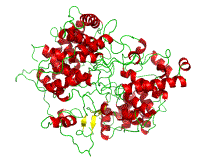β-Amyrin synthase from P ginseng (β-AS) catalyzes the biosynthesis of the cyclization of oxidosqualene into Oleanane-type saponins, thereby reducing the amount of steroid formation. However, the 3D structure of β-AS has not been firmly established. To finding the novel inhibitors, a 3D structure model of β-AS protein was constructed based on the structure of the template human oxidosqualene cyclase. After virtual screening technique of β-AS, a novel natural compound (8442257) has been found with the lowest affinity energy. Then we identify that Leu287 is the most important anchoring residues for binding with 8442257 because it has strong vdW interaction with inhibitor. Ser413 and Trp613 are important residues because they make hydrogen bonds with inhibitor. Our results may be helpful for further experimental investigations.
ZHAN Dong-Ling
,
WANG Song
,
HAN Wei-Wei
,
LIU Jing-Sheng
. Study of Homology Modeling and High-throughout Screening of a New Inhibitor of Panax β-AS[J]. Acta Chimica Sinica, 2012
, 70(03)
: 217
-222
.
DOI: 10.6023/A1108313
1 Zhu, G.-Y.; Li, Y.-W.; Hua, D.-K.; Jiang, Z.-H.; Yu, Z.-L.; Fong, W.-F. J. Agric. Food Chem. 2011, 59(1), 200.
2 Li, J.; Xie, Z.-Z.; Tang, Y.-B.; Zhou, J.-G.; Guan, Y.-Y. Eur. J. Pharmacol. 2011, 652, 104.
3 Han, J.-Y.; In, J. G.; Kwon, Y. S.; Choi, Y. E. Phytochemistry2010 , 71(1), 36.
4 Tetsuo, K.; Masaaki, S.; Yutaka, E. Eur. J. Biochem. 1998,256, 238.
5 Zhao, X.; Wang, S.; Xu, X.-H.; Huang, X.-R. Acta Chim. Sinica 2009, 67, 1835 (in Chinese). (赵熹, 王嵩, 徐晓华, 黄旭日, 化学学报, 2009, 67,1835.)
6 Wang, S.; Huang, X.-R.; Gao, X.-F.; Zhao, X.; Sun, C.-C. Chem. J. Chin. Univ. 2006, 27(3), 535 (in Chinese). (王嵩, 黄旭日, 高雪峰, 赵熹, 孙家钟, 高等学校化 学学报, 2006, 27(3), 535.)
7 Kiefer, F.; Arnold, K.; Künzli, M.; Bordoli, L.; Schwede, T.Nucleic Acids Res. 2009, 37, 387.
8 Arnold, K.; Bordoli, L.; Kopp, J.; Schwede, T. Bioinformatics 2006, 22, 195.
9 Trott, O.; Olson, A. J. J. Comput. Chem. 2010, 31, 455.
10 Huey, H.; Morris, G. M.; Olson, A. J. J. Comput. Chem.2007, 28, 1145.
11 Han, W.-W.; Zhou, Y.-H.; Yao, Y.; Li, Z.-S. Polymer 2006,47, 7953.
12 Han, W.-W.; Li, Z.-S.; Zheng, Q.-C.; Sun, C.-C. J. Theor. Comput. Chem. 2006, 5, 433.
13 Affinity User Guide, Accelrys Inc, San Diego, USA, 1999.
14 Han, W.-W.; Zhou, Y.-H.; Yao, Y.; Li, Z.-S. J. Mol. Struct.2007, 815, 87.
15 Thoma, R.; Schulz-Gasch, T.; D-Arcy, B.; Benz, J.; Aebi, J.; Dehmlow, H.; Hennig, M.; Stihle, M.; Ruf, A. Nature 2004, 432, 118.
16 Benkert, P.; Künzli, M.; Schwede, T. Nucleic Acids Res. 2009, 37, 510.


